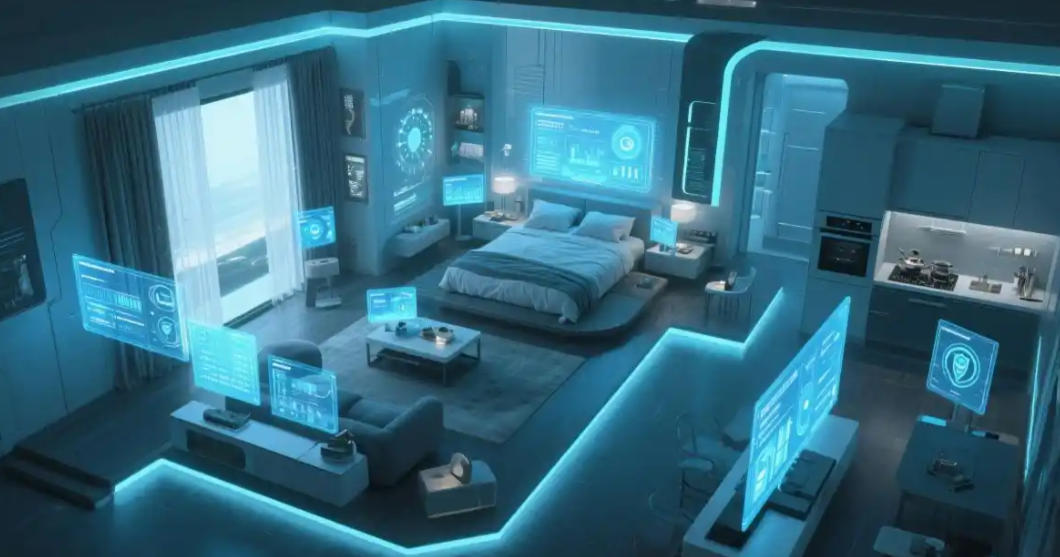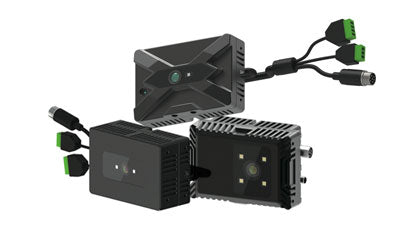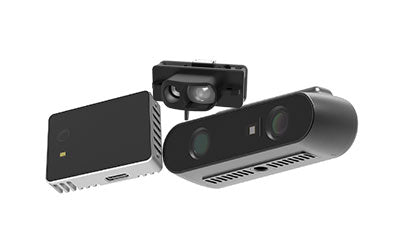How ToF Sensors Transform Smart Homes with 3D Depth and AI Power

How Do ToF Sensors Make Smart Homes More Intelligent and Touchless?
With the widespread adoption of smart home devices, people are demanding higher spatial awareness capabilities within their living environments. Traditional home sensors have limitations in precision, response speed, and environmental adaptability, while the emergence of Time of Flight Sensors (ToF Sensors) has completely transformed the way smart home devices interact and function. This article explores the applications, advantages, and future trends of technologies such as 3D ToF Sensors, Sensor 3D ToF, and 3D ToF Modules in smart homes.
What Exactly is a Smart Home?
A smart home refers to a modern living environment where advanced information technology, the Internet of Things (IoT), artificial intelligence (AI), and automation systems connect various household devices and facilities (such as lighting, appliances, security systems, HVAC, and curtains) to enable remote control, automated management, and intelligent services.
In simple terms, smart homes allow users to operate and manage household devices via smartphones, tablets, voice assistants, or other smart terminals. Examples include:
-
Smart Lighting: Automatically adjusts brightness and color based on time or ambient light, and can be controlled remotely.
-
Smart Security: Monitors home safety in real time using cameras, locks, and sensors, and triggers automatic alerts in case of unusual events.
-
Smart Appliances: Refrigerators, washing machines, air conditioners, etc., can be controlled remotely or run automatically, enhancing convenience.
-
Energy Management: Smart thermostats or meters optimize energy usage and reduce consumption.
Smart homes not only enhance comfort and convenience but also improve safety, energy efficiency, and provide personalized experiences through data analysis.
Typical Applications of ToF in Smart Homes
In the smart home field, 3D ToF Camera Modules and ToF Sensor Cameras have become core sensors. Thanks to their high precision, low latency, and all-weather adaptability, they are widely used in various smart home scenarios, enhancing user experience and device intelligence. Below are some typical applications:
-
Gesture Control
Using ToF Depth Sensors and ToF Image Sensors, smart home devices can accurately capture user gestures, enabling true touchless operation. For example, TVs, air conditioners, and lighting systems can recognize gestures through 3D ToF Cameras, allowing users to turn devices on/off, adjust volume, set temperatures, or change lighting brightness without physical contact.
-
Advantages: Compared to traditional infrared gestures or camera-based recognition, ToF technology offers faster response times and more accurate depth sensing, even in low-light environments.
-
Technical Highlights: The precise distance measurement provided by ToF Sensor Modules enables multi-gesture recognition, continuous motion tracking, and virtual button operations, providing a more natural and smooth interaction experience.
-
Future Trend: Combining AI + ToF Technology, gesture control will extend beyond single devices to full-home coordination. A single gesture could simultaneously control lights, curtains, music, and air conditioning, creating a truly “touchless” smart home experience.
-
Indoor People Counting
With ToF Ranging Sensors, ToF Sensor Modules, and ToF Sensor Cameras, smart home systems can count the number of people in a room in real time, track movement patterns, and monitor dwell time, optimizing energy management and space utilization.
-
Application Example: In living rooms or meeting areas, the system can automatically adjust air conditioning speed, temperature, and lighting brightness based on occupancy, reducing unnecessary energy consumption while improving comfort.
-
Technical Advantage: Unlike traditional cameras, 3D Time of Flight Sensors do not rely on ambient light and can accurately count people even at night or in bright environments, minimizing false or missed counts.
-
Extended Applications: Integrated with IoT smart home platforms, ToF people-counting data can enable smart alerts—for instance, notifying if someone stays in the kitchen too long, or automatically adjusting environmental devices for safety and convenience.
-
Security Monitoring
Through ToF Distance Sensors, ToF Depth Cameras, and ToF Depth Sensors, smart security devices can achieve high-precision intrusion detection and anomaly recognition, maintaining stable performance even in low-light, complex, or reflective environments.
-
Functional Advantages: ToF technology provides precise depth information, allowing the system to identify objects and people, distinguish between pets, family members, or strangers, and effectively reduce false alarms.
-
Technical Highlights: The high-resolution measurement capability of ToF Sensor Modules (e.g., ToF Sensor Resolution) allows micro-movement detection, such as slightly opened doors or moving small objects, triggering alerts.
-
Future Applications: With AI + ToF Camera Modules, future security systems could perform behavior analysis and anomaly prediction, integrating with home automation. For example, detecting an intruder could simultaneously trigger alarms, lights, and door locks, enhancing overall home security intelligence.
-
Other Innovative Applications
Beyond gesture control, people counting, and security monitoring, ToF 3D Camera Images enable additional innovative smart home applications:
-
Smart Home Navigation: Robotic vacuum cleaners can use ToF Ranging Sensors to map rooms accurately and avoid obstacles more effectively.
-
Environmental Awareness: Using ToF Depth Sensors, smart lighting and curtains can automatically adjust based on room layout and object height.
-
Health Monitoring: Combined with ToF Sensor Distance and AI algorithms, the system can monitor elderly movement patterns or sleeping posture, supporting health management.
In summary, ToF Sensor Applications have enormous potential in smart homes. They not only enhance user experience and device intelligence but also drive the evolution of smart homes toward a “touchless” future. With the continued growth of the ToF Sensor Market and the widespread adoption of 3D ToF Modules, more smart home products will leverage high-precision, low-latency, all-weather ToF technology to achieve intelligent upgrades.
Advantages of ToF Compared with Traditional Depth Sensors
In the field of smart homes, traditional depth sensors such as structured light sensors and stereo vision sensors were once the mainstream choice. However, as smart devices increasingly demand higher precision, real-time performance, and environmental adaptability, ToF (Time of Flight) technology has demonstrated unique advantages and is rapidly becoming the new favorite of the industry.
-
High Precision and Long-Range Measurement
Compared with traditional depth sensors, the ToF Sensor Range can achieve accurate distance measurement from a few centimeters to several meters, supporting wide indoor spatial awareness. Whether for gesture control, security monitoring, or appliance positioning, the 3D ToF Sensor provides precise depth information and reliable spatial perception for smart home devices.
-
Application Example: With a ToF Ranging Sensor, robotic vacuum cleaners can accurately detect furniture positions and room layouts, avoid collisions, and optimize cleaning paths.
-
Keyword Coverage: tof range; tof distance sensor; tof depth sensor; 3d time of flight sensor; tof sensor module
-
Fast Response and Low Latency
ToF Time of Flight technology achieves millisecond-level distance measurement, far exceeding the processing speed of structured light or stereo vision systems.
-
Application Value: In smart homes, gesture control, dynamic people counting, and security monitoring rely on the ToF Sensor Camera for quick response and low-latency data, ensuring instant operation and system safety.
-
Keyword Coverage: tof sensor uses; tof image sensor; tof time; tof system; tof sensor camera
-
Strong Environmental Adaptability
Traditional depth sensors are easily affected by ambient lighting, shadows, and reflective surfaces, while the ToF Depth Sensor uses actively emitted infrared light for distance measurement, ensuring stable performance in bright, dark, or reflective environments.
-
Advantage Explanation: Even at night or under complex lighting or reflective conditions, the ToF Sensor Range maintains high measurement accuracy, providing reliable data for home security, indoor monitoring, and health tracking.
-
Keyword Coverage: tof depth camera; tof distance; tof proximity sensor; tof sensor range; tof sensor resolution
-
Miniaturization and Modular Design
Modern 3D ToF Modules and ToF Camera Modules are compact and easily integrated into smart home devices such as TVs, air conditioners, lighting systems, and home robots. They enhance product functionality and design flexibility.
-
Advantage Explanation: Modular design reduces manufacturing costs while enabling easier upgrades and maintenance, offering greater innovation potential for smart home manufacturers.
-
Keyword Coverage: 3d tof module; 3d tof camera module; sensor 3d tof; tof camera sensor; tof sensor module
In conclusion, ToF Technology not only overcomes the limitations of traditional depth sensors but also stands out with its high precision, low latency, environmental adaptability, and modular design—making it one of the fastest-growing technologies in the 3D Sensor Market. In the future, with deeper integration of ToF Sensor Applications into AI + IoT, smart homes will become even more intelligent, achieving a truly 'touch-free' interactive experience.
Technical Challenges and Solutions
Despite the significant advantages of ToF Sensor Applications in smart homes, several technical challenges remain:
-
Low-Light and Reflective Surface Interference
By improving ToF Sensor Resolution and optimizing the signal processing algorithms of the ToF Sensor Module, distance measurement accuracy in complex environments can be significantly enhanced. -
Power Consumption and System Lifespan
Utilizing low-power ToF Camera Sensors and implementing intelligent sleep mode strategies can extend device lifespan while maintaining real-time performance. -
Cost and Integration Difficulty
By combining 3D Semiconductor processes with modular 3D ToF Module design, manufacturers can reduce production costs and accelerate time to market.
Future Outlook: ToF Empowering Smart Home Upgrades
As the smart home industry continues to evolve, ToF Sensor Uses and ToF Applications will play an increasingly vital role, delivering higher levels of human-machine interaction and intelligent living experiences.
-
AI + ToF: Intelligent Motion Recognition and Environmental Adjustment
By integrating ToF Systems with AI, smart home devices can achieve more accurate motion recognition, behavior prediction, and environmental adjustment.
-
Example: When a user enters a room, smart lighting can automatically adjust brightness based on the number of people and activity type; air conditioners and purifiers can adapt airflow and temperature according to user position and motion.
-
Technical Advantage: Combining ToF Depth Sensors and ToF Camera Modules enables the system to capture micro-movements, perform high-precision gesture recognition, and deliver smooth, natural interaction.
-
Keyword Coverage: tof sensor applications; tof sensor uses; tof camera; tof image; tof depth sensor
-
5G + ToF: Real-Time Cloud Analysis and Response
The combination of 5G’s high-speed, low-latency network with ToF Technology will greatly enhance data transmission and processing capabilities in smart homes.
-
Example: ToF 3D Camera Images can be uploaded to the cloud for real-time behavioral analysis and environmental modeling, enabling remote monitoring and intelligent coordination. For instance, if an abnormal movement is detected, the system can trigger alerts and send instant notifications via mobile app.
-
Technical Highlights: The high-speed depth data acquisition of the ToF Sensor Camera, when combined with 5G, ensures millisecond-level responsiveness, improving automation and synchronization across the entire home.
-
Keyword Coverage: tof sensor camera; tof sensor module; tof camera module; tof sensor distance; tof proximity sensor
-
Multi-Device Collaboration: Whole-Home Spatial Awareness
In the future, smart homes will support multiple 3D ToF Camera Modules working collaboratively to create an integrated spatial awareness system.
-
Application Value: ToF Depth Cameras and ToF Sensor Modules across rooms will share depth data to achieve furniture recognition, person tracking, gesture interaction, and automated device coordination.
-
Smart Function Example: Using ToF Ranging Sensors and ToF Time of Flight Sensors, smart robots can adjust cleaning routes based on real-time layouts, while smart lighting and curtains adapt automatically to occupants’ positions and activities.
-
Keyword Coverage: tof 3d camera images; tof range sensor; tof depth camera; tof sensor resolution; tof system
-
For Designers and Content Creators
Smart home product designers and creators should closely monitor ToF Sensor Market trends and leverage the capabilities of ToF Proximity Sensors, ToF Depth Sensors, and 3D ToF Modules to deliver safer, more convenient, and energy-efficient user experiences.
-
Design Advice: Combine AI algorithms to enhance ToF Sensor Camera data processing, improving gesture recognition, behavior prediction, and environmental adjustment. Low-power ToF Sensor Modules can further extend device lifespan.
-
Future Trend: As the 3D Sensor Market expands, ToF technology will see broader use in smart homes, security systems, health monitoring, and energy management—helping homes become more efficient, intelligent, and contact-free.
ToF Technology holds immense potential for the future of smart homes. Through the deep integration of AI + 5G + ToF Systems, it will enable comprehensive spatial sensing, real-time interaction, and efficient management, creating a smarter, more convenient, and energy-saving home experience for users.
Conclusion
Technologies such as Time of Flight Sensors, 3D ToF Sensors, and ToF Camera Modules are propelling smart homes into a new “touchless interaction” era. They not only enhance precision in gesture control, indoor monitoring, and people counting but also provide new momentum for energy efficiency and automation. In the future, with the integration of AI + 5G + ToF Technology, smart homes will become more intelligent, efficient, and human-centered.
Synexens 3D Of RGBD ToF Depth Sensor_CS30
Our professional technical team specializing in 3D camera ranging is ready to assist you at any time. Whether you encounter any issues with your TOF camera after purchase or need clarification on TOF technology, feel free to contact us anytime. We are committed to providing high-quality technical after-sales service and user experience, ensuring your peace of mind in both shopping and using our products.
-
で掲示されます
CS30





